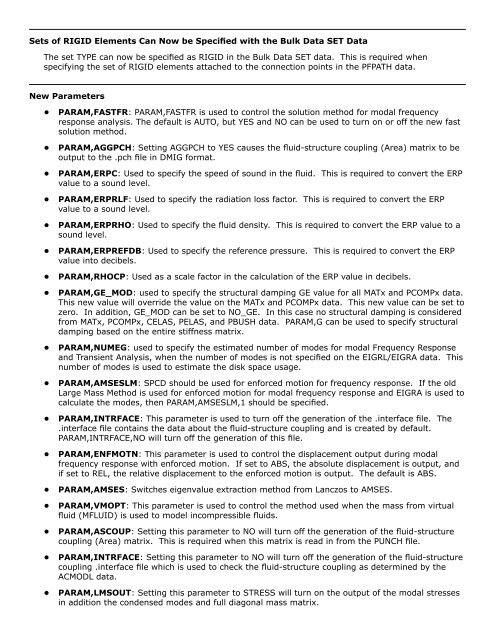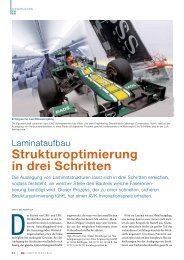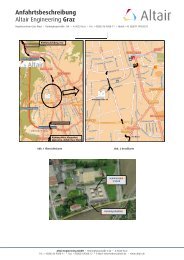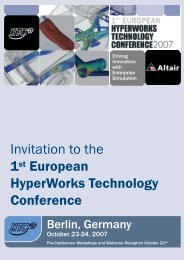HyperWorks 12.0 Release Notes
HyperWorks 12.0 Release Notes
HyperWorks 12.0 Release Notes
Create successful ePaper yourself
Turn your PDF publications into a flip-book with our unique Google optimized e-Paper software.
Sets of RIGID Elements Can Now be Specified with the Bulk Data SET Data<br />
The set TYPE can now be specified as RIGID in the Bulk Data SET data. This is required when<br />
specifying the set of RIGID elements attached to the connection points in the PFPATH data.<br />
New Parameters<br />
• PARAM,FASTFR: PARAM,FASTFR is used to control the solution method for modal frequency<br />
response analysis. The default is AUTO, but YES and NO can be used to turn on or off the new fast<br />
solution method.<br />
• PARAM,AGGPCH: Setting AGGPCH to YES causes the fluid-structure coupling (Area) matrix to be<br />
output to the .pch file in DMIG format.<br />
• PARAM,ERPC: Used to specify the speed of sound in the fluid. This is required to convert the ERP<br />
value to a sound level.<br />
• PARAM,ERPRLF: Used to specify the radiation loss factor. This is required to convert the ERP<br />
value to a sound level.<br />
• PARAM,ERPRHO: Used to specify the fluid density. This is required to convert the ERP value to a<br />
sound level.<br />
• PARAM,ERPREFDB: Used to specify the reference pressure. This is required to convert the ERP<br />
value into decibels.<br />
• PARAM,RHOCP: Used as a scale factor in the calculation of the ERP value in decibels.<br />
• PARAM,GE_MOD: used to specify the structural damping GE value for all MATx and PCOMPx data.<br />
This new value will override the value on the MATx and PCOMPx data. This new value can be set to<br />
zero. In addition, GE_MOD can be set to NO_GE. In this case no structural damping is considered<br />
from MATx, PCOMPx, CELAS, PELAS, and PBUSH data. PARAM,G can be used to specify structural<br />
damping based on the entire stiffness matrix.<br />
• PARAM,NUMEG: used to specify the estimated number of modes for modal Frequency Response<br />
and Transient Analysis, when the number of modes is not specified on the EIGRL/EIGRA data. This<br />
number of modes is used to estimate the disk space usage.<br />
• PARAM,AMSESLM: SPCD should be used for enforced motion for frequency response. If the old<br />
Large Mass Method is used for enforced motion for modal frequency response and EIGRA is used to<br />
calculate the modes, then PARAM,AMSESLM,1 should be specified.<br />
• PARAM,INTRFACE: This parameter is used to turn off the generation of the .interface file. The<br />
.interface file contains the data about the fluid-structure coupling and is created by default.<br />
PARAM,INTRFACE,NO will turn off the generation of this file.<br />
• PARAM,ENFMOTN: This parameter is used to control the displacement output during modal<br />
frequency response with enforced motion. If set to ABS, the absolute displacement is output, and<br />
if set to REL, the relative displacement to the enforced motion is output. The default is ABS.<br />
• PARAM,AMSES: Switches eigenvalue extraction method from Lanczos to AMSES.<br />
• PARAM,VMOPT: This parameter is used to control the method used when the mass from virtual<br />
fluid (MFLUID) is used to model incompressible fluids.<br />
• PARAM,ASCOUP: Setting this parameter to NO will turn off the generation of the fluid-structure<br />
coupling (Area) matrix. This is required when this matrix is read in from the PUNCH file.<br />
• PARAM,INTRFACE: Setting this parameter to NO will turn off the generation of the fluid-structure<br />
coupling .interface file which is used to check the fluid-structure coupling as determined by the<br />
ACMODL data.<br />
• PARAM,LMSOUT: Setting this parameter to STRESS will turn on the output of the modal stresses<br />
in addition the condensed modes and full diagonal mass matrix.





